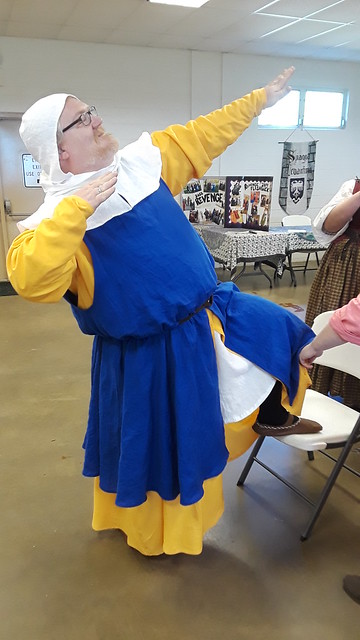The first was the Shire's own event, Revenge of the Stitch, which is now in its sixth iteration, making it a truly annual event in my book. Some people, I know, would not find staying up almost all night to hand-sew linen very enjoyable, but it gets my competitive juices flowing, and I always learn some aspect of garb-making that had previously eluded me. This year -- my fourth such challenge -- I helped Meisterin Johanna's team make a houppelande with undertunics and hood for Master Richard Wyn in his heraldic colors. I was rather tired after the competition, but I did manage this "action shot" of Master Richard posing in his new duds:

Notice the leather shoes -- they were made during the competition by one of our six team members. I think we were the only team that made footwear this year. We didn't win, but I think Wyn (as he is usually called) looks spiffy in his new outfit.
Half a fortnight later, I was crossing the Chesapeake Bay again for Spring Crown Tournament. The rain held off, the competitors fought fiercely and cleanly, and Duke Cuan won his eighth reign. He and his consort will step up to the throne at Fall Coronation, to be held in Our Glorious Barony of Storvik. My friend Lady Kunigunde will be the autocrat/steward of Fall Coronation, which will have a 16th-century German theme, and I feel highly motivated to make myself a suitable dress for the occasion.
My friend Lady Meleri was the head cook for both of the Spiaggia Levantina feasts, and were they ever good! I could barely finish the last couple of courses at each meal. Meleri dedicated the Revenge of the Stitch feast to one of her schoolteacher colleagues who had operated a catering business on the side ... and who had just passed away from cancer, at a much-too-young age.
Just this past weekend, I attended the 30th edition of Highland River Melees, the signature event of the Barony of Highland Foorde, which encompasses the westernmost counties of Maryland (and is surrounded on three sides by the Kingdom of Aethelmearc). Two of my friends were "retiring" after serving as Highland Foorde's Baron and Baroness for the past five years. I talked with one woman who came all the way from Massachusetts to attend the event because she is a good friend of the new Baroness of Highland Foorde. I have a lot of experience driving between Massachusetts and Maryland, so I know what a haul that is!
During the afternoon, I took a class in using wire to make jewelry that isn't Viking-wire-knitted. Here are my results:

I posed these pins in the order in which I made them from top to bottom. Not a bad start, I'd say. :-) The bottom fibula had three beads at first -- a red bead between the two blue beads -- but the red one must have had a crack in it, because it fell off and got lost. Ah, well.




